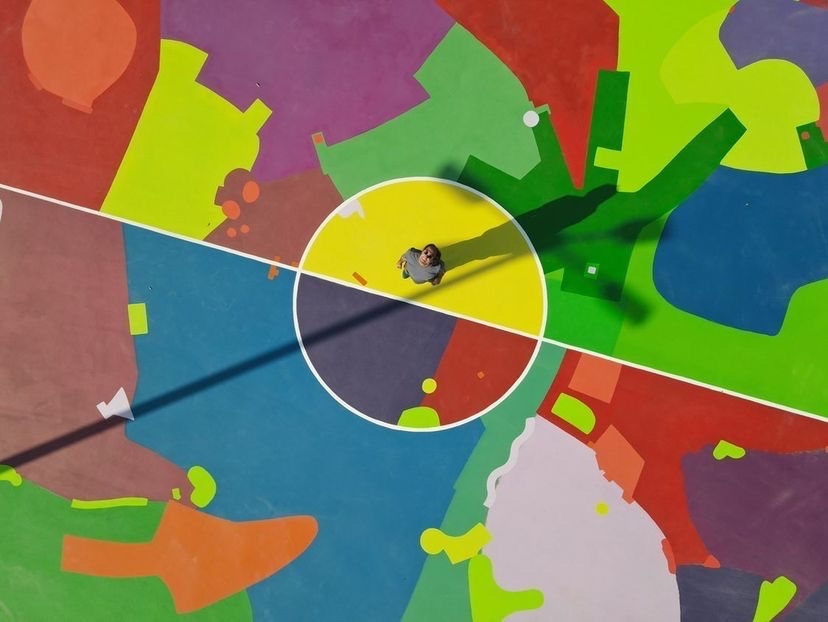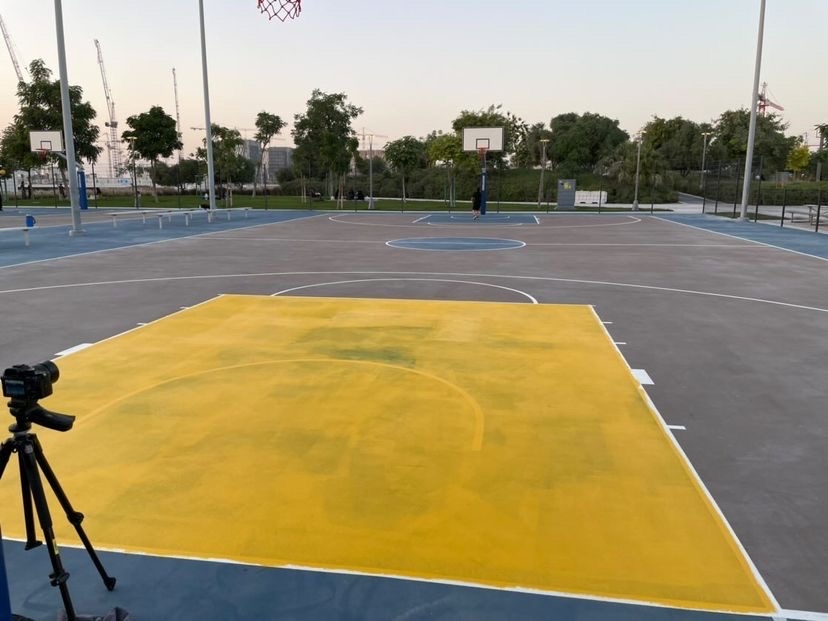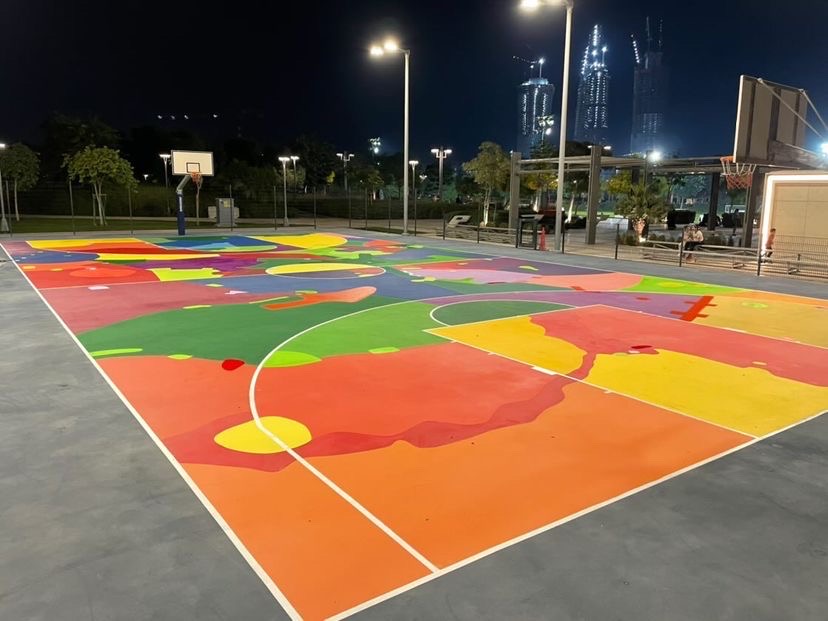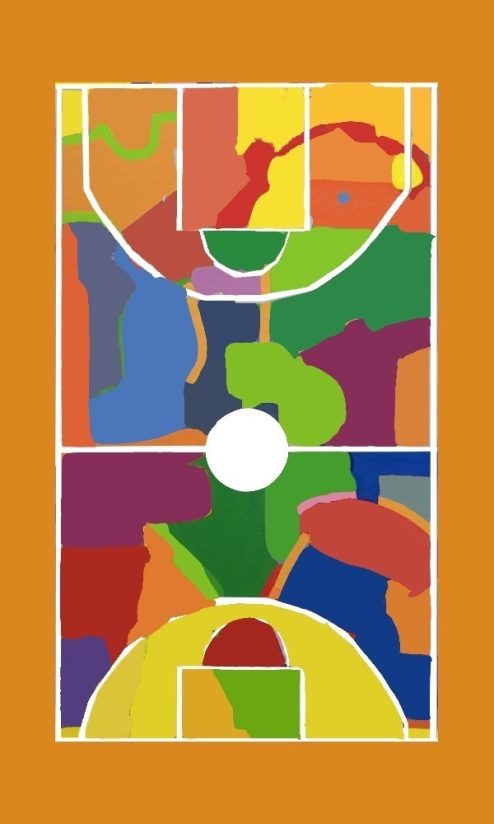Art Comes to Play!
When Michael Perrone, Assistant Professor, VCUarts Qatar embarked on a large-scale street art project, he was assisted by his students, friends and some enthusiastic onlookers at the Crescent Park in Lusail, making the completed colourful and distinct Perrone stamp on the basketball court, a work of collaboration. By Sindhu Nair
American artist Michael Perrone has been teaching art at Virginia Commonwealth University of Qatar (VCUarts Qatar) for nine years and has had a prolific career being a part of many ambitious art projects within the country either as part of Qatar Museums or as part of the faculty of VCUArts Qatar. But what he has recently completed is a humungous street art project, an extension of Pow! Wow! International Street Art Festival where he was asked to create an artwork on the widest platform, of approximately around 50 x 90 feet (15 x 27 meters) — a basketball court at Crescent Park Lusail!
“It was super exciting, as I’ve never done an artwork this large or created a work that could interact with so many people in such a direct way, with them literally moving through and touching the work,” says Perrone about his experience.
The enormity and the scale of the project were not something Perrone gave much consideration until he finally began the work. “I mostly wanted to create a preliminary sketch that the Qatar Museums Public Art team would like and one that the client, Qatari Diar, was willing to support. As I began to work on the actual painting, putting paint down on the court with brushes and paint rollers, and as I began to talk with some of my assistants, (former and current students at VCUarts Qatar), the process became more organic and flowing, much like any other painting I might do,” he says.
The ultimate gift for any artist is when the work they believe in and have put their heart and soul into is appreciated and seen. In this case, there was no lack of both, the work was seen and appreciated even while the artist was completing his work. “You go in with an idea of what you want to create, in this case, I had a printout of my digital ’sketch’, but as you start painting, you have to respond to what is happening on the surface. So, you change things slightly, you let the process have a say in the making of the artwork and this is where it got really exciting. Magnify that by the size of the ‘canvas’ (the court dimensions), and the excitement was that much greater.”
Challenges Rife
That being said, the scale and size of the canvas had multiple challenges. “The wind, dust, leaves, people asking when they can start playing, the stray basketball from the neighbouring court rolling across our canvas, all of these things, although none overwhelming, did create some challenges. Additionally, for myself and some of my current students, the project came at a very hectic time of the year (the end of our fall semester). So, we were literally in the middle of final exams (critiques) and trying to wrap everything up before heading off to break. I was working at VCUArts Qatar in the mornings and then going to Jotun Paint to get supplies and then on to the court, working five to eight hours before cleaning up and heading home. It was seven long days… sometimes dealing with the afternoon heat, but mostly it was a lot of fun and we were able to keep the excitement going,” remembers Perrone.
The challenges were not confined to the scale, there were other factors like lighting that were a hindrance in the process.
“The courts have ample lighting, but it was at times difficult to fully see the painting surface. I would often check the next day, at the beginning of our session, to see if the surface was covered adequately during the previous night’s painting. This being Qatar, there was the constant presence of dust. At times, the dust was worsened by strong winter winds, but we were lucky to have the grounds crew help us out a bit with sweeping and then with some water hoses. Blowing leaves and sometimes insects would unexpectedly make their way into a freshly painted area, and there wasn’t really much we could do about that. Also, due to the size, we sometimes trapped ourselves in and sometimes accidentally walked across areas that still had wet paint. The time and energy this activity took were immense. It was an exhausting process, but well worth the effort!
Collaborative Work
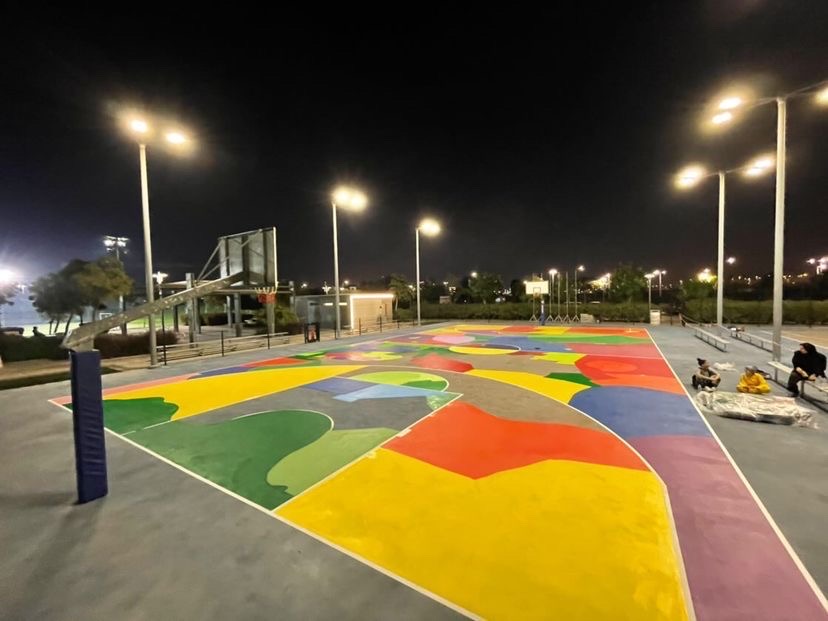 Perrone started alone, one Friday, on November 26 and his colleague Brynn Higgins-Stirrup joined him for a few hours. Over the next seven days, Perrone put in 40 plus hours, “just painting, collecting supplies and navigating the new roadways to Crescent Park. My students, some current and some alumni, (Haneen Elbasuni, Amira Radhi, Alice Aslam, Aisha Al-Abdullah, and friend Fatima Al Yousef) started to come and help, and in total, there were six ‘official’ assistants, who put in a total of close to 80 hours.”
Perrone started alone, one Friday, on November 26 and his colleague Brynn Higgins-Stirrup joined him for a few hours. Over the next seven days, Perrone put in 40 plus hours, “just painting, collecting supplies and navigating the new roadways to Crescent Park. My students, some current and some alumni, (Haneen Elbasuni, Amira Radhi, Alice Aslam, Aisha Al-Abdullah, and friend Fatima Al Yousef) started to come and help, and in total, there were six ‘official’ assistants, who put in a total of close to 80 hours.”
Friends joined to keep Perrone company and a few of them joined in, putting in some work too in between.
“My young friend Phi Phi Rousere (age five) helped a bit and so did her mom Clara. A few times we had some young passer-by ask if they could paint a bit, so we let them. That was a really nice aspect of the project, having random park-goers seeing what we were doing and then getting involved. It could be a model for a future project, where there is even more ‘crowd sourcing’ or ‘community involvement’!”
Working with QM
Perrone has been guiding future artists through his teaching while he has actively contributed to the local art scene in Qatar, courtesy of Qatar Museums.
“I’ve been extremely fortunate to have worked with Qatar Museums on many occasions, and I’m grateful for their interest in my work and for their continued support. I started working with them in 2018 when I was a resident at the Fire Station Artist in Residence programme. That residency culminated in a wonderful group exhibition, called ‘Infinite Dimensions’, during the summer of 2019. I have also participated in another small group exhibition, ‘Percussive Excavation’, with Thomas Modeen and Ben Barbour, at the Fire Station Workshop #3 in 2018, and a recent show curated by Amal Ali, called ‘Glimpse of Nature’.”
Another interesting street art project in which Perrone participated was the QM-initiated Jedariart public art project, which happened right at the height of Covid lockdowns.
“For this mural, I painted on a large wall under the overpass near Doha Festival City,” he says. But the intriguing information of this project was that the entire art was done remotely, with Perrone, who was teaching remotely from the US communicating with his students from VCUarts Qatar over ZOOM and WhatsApp as he guided his students to complete the work he conceptualised.
“My Project Manager, Salma Awad, led a team of four people, to paint the 20-meter-long wall. I was so overwhelmed when I first saw it last January. When I first got back to Qatar, after being in the USA for the whole fall semester, it was a surreal experience to actually see this painting of mine, which I had only seen virtually, until that point. I’m really proud of that project; the size, the job that the students did were commendable. The joyful feeling the painting gives me every time I drive by, this work of mine is a highlight of my painting career until the Lusail Basketball Project happened.”
About the work that Qatar Museums has undertaken to give the country a strong art education, Perrone, has immense respect.
Through programmes like the Fire Station, or more recently the public art initiatives like Jedariart and Pow Wow Worldwide, art is making its way to peoples’ everyday lives, he says.
“Added to this, the amazing museum exhibitions and growing collection of contemporary art within the country, have created a solid foundation for art education to emerge. New galleries are opening; Al Hosh Gallery, Studio 7, and Eiwan Al Gassar Gallery are all examples of a public that appreciates and encourages art,” he says.
Looking Forward
Perrone has been at the helm of the art revolution that has happened in the country and he looks back at his tenure here, as a teaching faculty and says, “I’ve been teaching painting in Qatar now for nine years. Our painting programme at VCUarts Qatar is in its eleventh year, and although there have been other art programmes in Qatar, I don’t think there has been any fine art educational endeavor as impactful as what we’ve been able to accomplish here.
“I’m continually impressed by the developments of our students, both while they are still enrolled, and even more so as they venture out to form their careers. The Doha Fire Station (a Qatar Museums initiative) has been instrumental in the growth of the emerging Qatari art scene,” he says.
Doha has a unique mix of art that intends to form a connection with its people, like the public artworks at the Hamad International Airport, that offer citizens the opportunity to interact with art, even when they least expect it.
“And by bringing monumental, one-of-a-kind works to Qatar – like Richard Serra’s East-West / West-East, in Zekreet, it is my hope that Qatar will begin to attract a worldwide audience of art pilgrims, who make the journey to Qatar specifically to see such masterworks.”
All Images from the artist.


